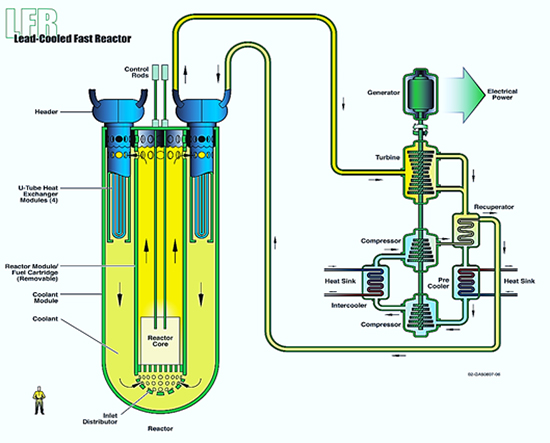
TECHNOLOGY
Generation IV
LFR (Lead cooled Fast Reactor)

Source: "A technology Roadmap for Generation IV Nuclear Energy Systems", U.S. DOE Nuclear Energy Research Advisory Committee and Generation IV International Forum, 12.2002, http://www.gen-4.org/PDFs/GenIVRoadmap.pdf [55]
The LFR is energy system based on lead fast neutron reactor. Cooling system is based on liquid lead or lead-bismuth alloy. In the concept closed fuel cycle is envisioned what makes possible to convert fertile uranium and to manage nuclear wastes, in particular actinides. The concept envisages full actinides management, so despite the fact that fuel cycle has not been decided yet, it has to ensure full actinides recycling. Fuel reprocessing and recycling can be executed in local fuel cycle facilities or central as well. Metal or nitride fuel with fertile uranium and transuranics use is under consideration. The LFR can be designed in tree various options. The most advanced is an idea of small battery with power of 50-150 MWe. Such reactor will be factory - fabricated unit with very long refuel service time (15 - 20 years). In fact, refuelling means core replacement for fuel recycling in spent one. Small and movable battery reactor is suitable for not developed grids and for growing countries. Reduced dimensions, reduced capital cost, high passive safety has caused the LFR fulfils generation IV goals in the best way among other GIF proposals. Unfortunately the battery solution needs long term R&D. Other options of the LFR, like modular 300-400 MWe reactor or large, 1200 MWe, monolithic unit, are under consideration. The LFR operates at 550ºC outlet temperature. 850ºC can be achieved after serious material's development. Secondary circuit working fluid is supercritical carbon dioxide at 552ºC/20 MPa or superheated water at 450ºC/18 MPa. It depends on exact design. US SSTAR (Small Secure Transportable Autonomous Reactor), representative of battery reactor, uses carbon dioxide. EU EISY (European Lead - cooled System), mid - size 600 MWe, uses superheated water. Both are pool type reactors with efficiency around 44%. Commercial development is planned in two stages. Until 2025 reactor operating with low temperatures and power should be ready. Until 2035 exact, more advanced constructions of LFR are envisioned. The LFR is targeted in electricity generation, hydrogen production and nuclear waste management. Further R&D in are of materials, corrosion control and fuel are necessary. [50],[51],[52],[54],[55],[56], [57],[58],[59]


-
Nuclear power industry|
Technology|
The electricity supply system aspect|
Economics|
Environment|
Public aspect|
Future|
Legislation|
References|